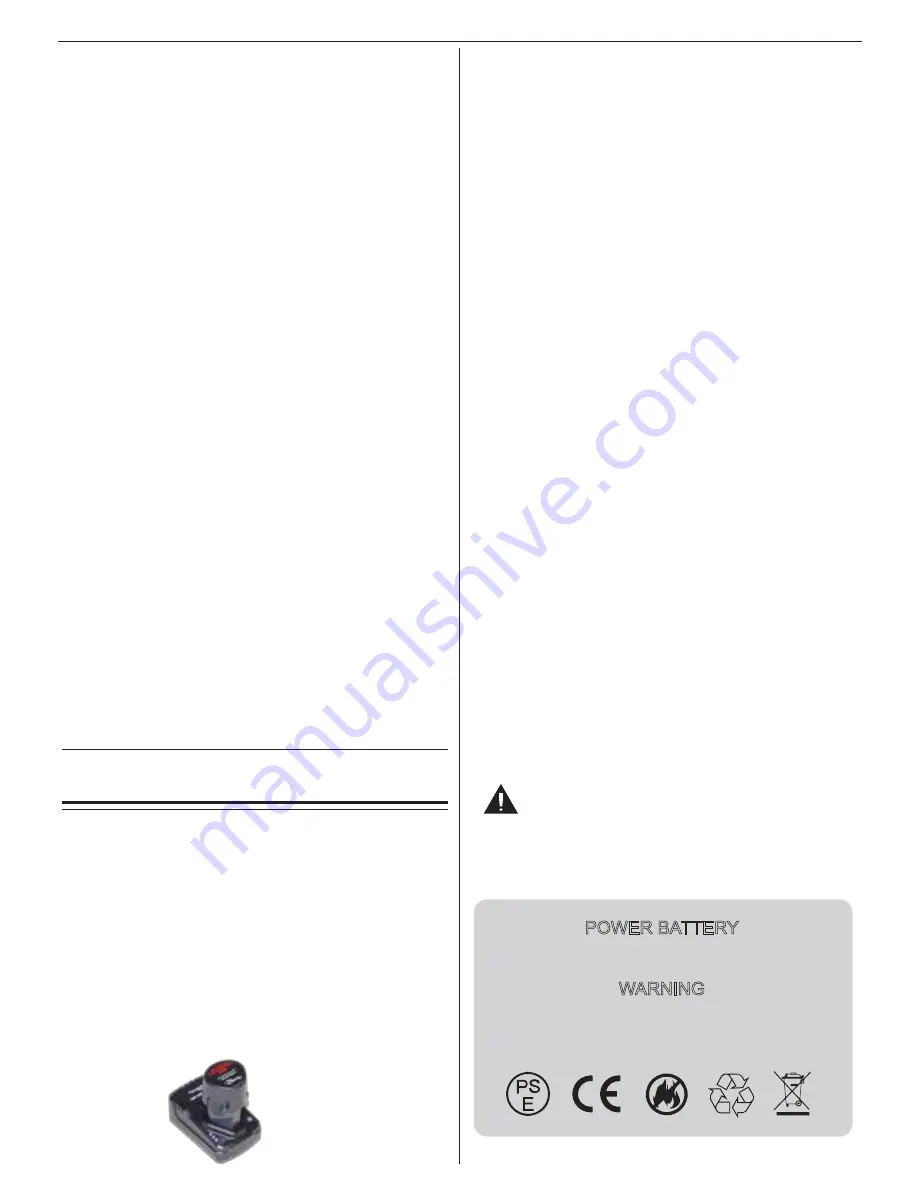
P.4
(d) Contents of opened battery cells may cause respiratory irritation. If
respiratory irritation is experienced due to exposure, move person to a
well-ventilated area immediately. If symptoms persist, seek medical
attention.
WARNING:
Burn hazard. Battery liquid may be flammable if exposed to sparks or
flames.
• Charge the battery packs only in Sprayers Plus chargers.
• DO NOT splash or immerse in water or other liquids. This may cause
premature cell failure.
• DO NOT store or use the tool and battery pack in locations where the
temperature may reach or exceed 105ºF(40ºC) (such as outdoor sheds or
metal buildings in the summer season).
Never attempt to open the battery pack for any reason. If battery pack
casing is cracked or damaged, do not insert into charger. Do not crush,
drop or damage battery pack. Do not use a battery pack or charger that has
received a sharp blow, been dropped, run over or damaged in any way.
Damaged battery packs should be returned to a service center for
recycling.
WARNING:
Fire hazard. Do not store or carry the battery in such a way that metal
objects can contact exposed battery terminals. For example, do not place
battery in aprons, pockets, toolboxes, product kit boxes, drawers, etc.
To prevent fire risk while transporting batteries, ensure battery terminals do
not come in contact with conductive materials such as keys, coins, hand
tools and the like. The US Department of Transportation’s Hazardous
Material Regulations (HMR) prohibits the transport of lithium-ion batteries
in commerce or on airplanes (i.e., packed in suitcases and carry-on
luggage) UNLESS they have proper short-circuit protection. When
transporting individual batteries, make sure that the battery terminals are
protected and well insulated from materials that could contact them and
cause a short circuit.
NOTE: Lithium- ion batteries should NOT be put in checked baggage.
The charger and battery pack can be left connected with the green LED
light glowing. The charger will keep the battery pack fresh and fully
charged.
The longest life and best performance can be obtained if the battery
pack is charged in an environment where the air temperature is
between 65ºF and 75ºF (18ºC-24º). DO NOT charge the battery pack
in an environment where the air temperature drops below 40ºF
(+4.5ºC), or rises above +105ºF (+40.5ºC). Follow these guidelines to
prevent serious damage to the battery pack.
The charger and battery pack may become warm to touch while
charging. This is normal and does not indicate a problem. To facilitate
the cooling of the battery pack after use, avoid placing the charger or
battery pack in a warm environment such as in a metal shed or an
uninsulated trailer.
If the battery pack does not charge properly:
a.) Check current at the outlet or receptacle by plugging in a lamp or
other appliance.
b.) Check to see if outlet or receptacle is connected to a light switch
which turns the power off when you turn off the lights.
c.) Move charger and battery pack to a location where the surrounding
air temperature is between approximately 65ºF and 75ºF(18º-24ºC)
d.) If charging problems persist, take the tool, battery pack and charger
to your local service center.
The battery pack should be recharged when it fails to produce sufficient
power on jobs that were previously easy to complete. DO NOT
CONTINUE with use under these conditions. Follow the charging
procedure to recharge the battery. You may also charge a battery used
pack when ever you desire with no adverse effect to the battery pack.
Foreign materials of a conductive nature such as, but not limited to,
steel wool, aluminum foil, or any buildup of metallic particles should be
kept away from charger cavities. Always unplug the charger from the
power supply when there is no battery pack in the cavity. Unplug
charger before attempting to clean.
Do not freeze or immerse charger in water or any other liquid.
WARNING:
Shock hazard. Do not allow any liquid to get inside charger.
Never attempt to open the battery pack for any reason. If the
plastic housing of the battery pack breaks or cracks, return to
a service center for recycling.
The best storage place is one that is cool and dry — away from direct
sunlight and excess heat or cold.
Long-term storage will not harm the battery pack or charger.
3.2 Storage Recommendations
4.1 IMPORTANT CHARGING NOTES
4. Charging Procedure
LEAVING THE BATTERY IN THE CHARGER
(1)
(2)
(3)
(4)
(5)
(6)
Li-ion 12V 2.2Ah/23.76wh
WARNING
POWER BATTERY
To reduce the risk of fire or burns, do not
disassemble, crush, puncture or short
external contacts.
Sprayers Plus chargers are designed to charge Sprayers Plus 12V battery
packs only.
Charging lights
1. Plug the charger into an appropriate outlet before inserting the battery pack.
2. A (fast) flashing red light indicates that the charger is ready to be used.
3. Insert the battery pack into the charger.
4. An illuminated red light indicates that the battery is being charged.
5. When the illuminated light changes from red to green, the battery is fully
charged.
6. A (slow) flashing red light indicates a charging error. Go to dealer for help.
Battery power light
(only works when charger is not plugged into the power outlet)
1. The 3 blue LED lights indicate the battery power.
2. 3 illuminated lights indicate that the battery is fully charged.
3. 1 illuminated light indicates low battery levels.
• 12V
Lithium-ion battery
( Parts: K7048 )
• 12V Charger
( Parts: K8002 )






























